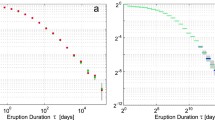Abstract
A simple Poisson process is more specifically known as a homogeneous Poisson process since the rateλ was assumed independent of time t. The homogeneous Poisson model generally gives a good fit to many volcanoes for forecasting volcanic eruptions. If eruptions occur according to a homogeneous Poisson process, the repose times between consecutive eruptions are independent exponential variables with meanθ=1/λ. The exponential distribution is applicable when the eruptions occur “at random” and are not due to aging, etc. It is interesting to note that a general population of volcanoes can be related to a nonhomogeneous Poisson process with intensity factorλ(t). In this paper, specifically, we consider a more general Weibull distribution, WEI (θ, β), for volcanism. A Weibull process is appropriate for three types of volcanoes: increasing-eruption-rate (β>1), decreasing-eruption-rate (β<1), and constant-eruption-rate (β=1). Statistical methods (parameter estimation, hypothesis testing, and prediction intervals) are provided to analyze the following five volcanoes: Also, Etna, Kilauea, St. Helens, and Yake-Dake. We conclude that the generalized model can be considered a goodness-of-fit test for a simple exponential model (a homogeneous Poisson model), and is preferable for practical use for some nonhomogeneous Poisson volcanoes with monotonic eruptive rates.
Similar content being viewed by others
References
Bain, L. J., 1978, Statistical Analysis of Reliability and Life-Testing Models: Marcel Dekker, New York, 450 p.
Klein, F. W., 1982, Patterns of Historical Eruptions at Hawaii Volcanoes: Journal of Volcanology and Geothermal Research, v. 12, p. 1–35.
Mulargia, F., Tinti, S., and Boschi, E., 1985, A Statistical Analysis of Flank Eruptions on Etna Volcano: Journal of Volcanology and Geothermal Research, v. 23, p. 263–272.
Parzen, E., 1962, Stochastic Processes: Holden-Day, San Francisco, 324 p.
Simkin, T., Seibert, L., McClelland, L., Bridge, D., Newhall, C., and Latter, J. H., 1981. Volcanoes of the World: Smithsonian Institution and Hutchinson Ross, Stroudsburg, Pennsylvania, 232 p.
Steel, R. G. D., and Torrie, J. H., 1980. Principles and Procedures of Statistics (2nd ed): McGraw-Hill, New York, 633 p.
Wickman, F. E., 1966, Repose-Period Patterns of Volcanoes: Ark. Mineral. Geol., v. 4, p. 291–367.
Wickman, F. E., 1976, Markov Models of Repose-Period Patterns of Volcanoes:in D. F. Merriam (Ed.), Random Processes in Geology: Springer, New York, p. 135–161.
Author information
Authors and Affiliations
Rights and permissions
About this article
Cite this article
Ho, CH. Nonhomogeneous Poisson model for volcanic eruptions. Math Geol 23, 167–173 (1991). https://doi.org/10.1007/BF02066293
Received:
Accepted:
Issue Date:
DOI: https://doi.org/10.1007/BF02066293




